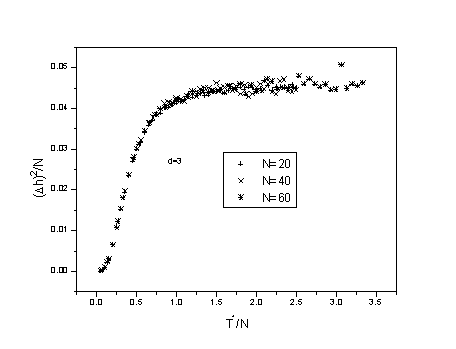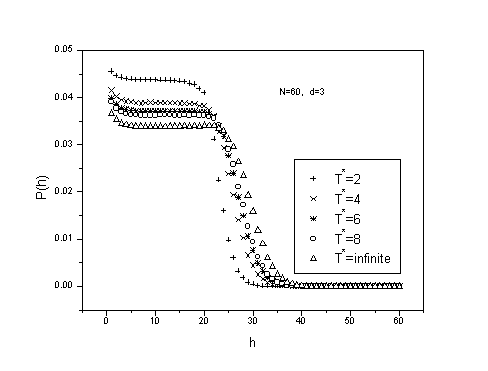
ACS PRF | ACS
All e-Annual Reports

40917-B6
Research in Statistical Physics of DNA Unzipping and Epitaxial Growth
Statistical Mechanics of a Chain in a Vertical Vibrating Tube
The compaction behavior of a granular material inside a vertical vibrating tube under gravity has been very well studied. Here we study the case when the granular material is replaced by a long chain of monomers, each of mass m. For convenience we take the cross-section of the tube to be a square of size d x d, under a gravitation field g. The tube with the chain is shaken by a sinusoidal vibration with angular frequency w and amplitude A. We study this model using a self-avoiding walk model. We find that fluctuation in the height of the chain obey a scaling behavior such that the fluctuation is proportional to the length of the chain. In addition, the distribution in the height of the chain obeys the Fermi distribution.
We can define an effective temperature T (with unit of energy) such that the kinetic energy per monomer due to shaking is equal to T (Boltzman constant taken to be 1) :
![]() .
.
In terms of G=Aw2/g, this can be written as T=mAGg/2.
We have simulated the system using a self-avoiding walk on a simple cubic lattice, with lattice constant a. A particular configuration of the chain is characterized by its total potential energy given by U(K)=Kamg. K is an integer given by
K=k1+ k2+ k3+ k4+ + kN
where the integers ki give heights (in units of a) of the i-th monomer. The average height h of the monomers in this configuration is then given by h=Ka/N.
The canonical partition function of the chain is given by
![]() ,
,
where the sum is over all configurations of the chain.
In terms of a dimensionless temperature T*=AG/(2a), the partition sum can be written as
![]()
The average height of the polymer over all possible configurations is given by
![]() .
.
The fluctuation in the average height is given by
![]()
The fluctuation (Dh)2 versus T* obey a scaling relation. Such a scaling plot is shown in Figure 1, where we have plotted (Dh)2/N versus T*/N. In Figure 2 we show the probability distribution P(h) as a function of h, for different temperatures T*=2,4,6,8 and „, for a chain with N=60 monomers, in a tube of width d=3, on the square lattice. From Figure 2 and from similar figures for larger N we can see that the distribution becomes a Fermi distribution for large N.

Figure 1

Figure 2